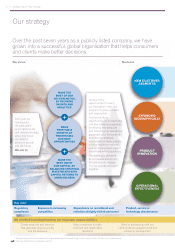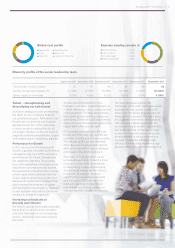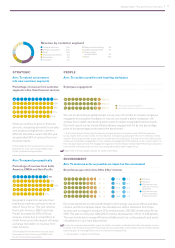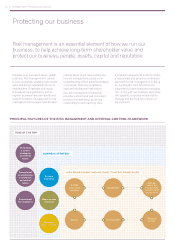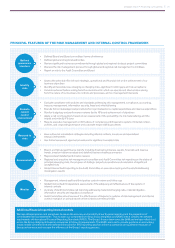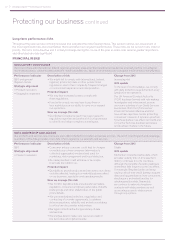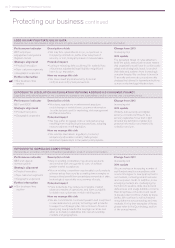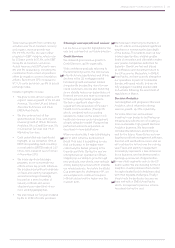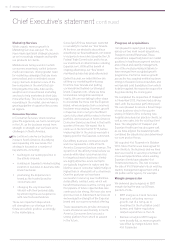Experian 2014 Annual Report Download - page 26
Download and view the complete annual report
Please find page 26 of the 2014 Experian annual report below. You can navigate through the pages in the report by either clicking on the pages listed below, or by using the keyword search tool below to find specific information within the annual report.
22 Strategic report • Protecting our business
Long-term performance risks
Throughout the year, we have critically reviewed and evaluated the risks Experian faces. This section outlines our assessment of
the most significant risks and uncertainties that could affect our long-term performance. These risks are not set out in any order or
priority. The list is not exhaustive and it is likely to change during the course of the year, as some risks assume greater importance
and others become less significant.
PRINCIPAL RISKS
REGULATORY COMPLIANCE
We must comply with international, federal, regional, provincial, state and other jurisdictional regulations and best practice, including but
not limited to privacy, consumer data protection, health and safety, tax, labour, environmental, anti-corruption and information security laws.
Performance indicator
EBIT and general
litigation trends
Strategic alignment
• Product innovation
• Geographic expansion
Description of risk
• We might fail to comply with international, federal,
regional, provincial, state or other jurisdictional
regulations, due to their complexity, frequent changes
or inconsistent application and interpretation.
Potential impact
• We may face increased costs to comply with
these regulations.
• If we fail to comply, we may have to pay fines or
face restrictions on our ability to carry on or expand
our operations.
How we manage this risk
• Our Global Compliance team has region-specific
regulatory expertise and works with our businesses
to identify and adopt compliance strategies.
Change from 2013
Increasing risk
2014 update
To the best of our knowledge, we comply
with data protection requirements in every
jurisdiction we operate in.
The UK Financial Conduct Authority
(‘FCA’) has been formed with rule-making,
investigative and enforcement powers
over some activities of our Credit Services
businesses. Both the US Consumer
Financial Protection Bureau and FCA
have similar objectives, tied to protecting
consumers’ interests. It remains uncertain
how these bodies may affect our Credit and
Consumer Services business processes
and business models in the future.
DATA OWNERSHIP AND ACCESS
Our products and services rely extensively upon data collected from public and private sources. The act of collecting and analysing large
quantities of this data generates more data, which augments our products and services.
Performance indicator
EBIT
Strategic alignment
• Product innovation
Description of risk
• Consumer privacy concerns could lead to changes
or restrictions in how consumer information is
collected, aggregated, analysed and used for
marketing, risk management and fraud detection.
• Our data providers could withdraw or be unable
to provide their data to us.
Potential impact
• Our ability to provide products and services to our clients
could be affected, leading to a materially adverse effect
on our business, reputation and operating results.
How we manage this risk
• We monitor legislative bills and educate lawmakers,
regulators, consumer and privacy advocates, industry
trade groups and other stakeholders in the public
policy debate.
• We use standardised selection, negotiation and
contracting of provider agreements, to address
delivery assurance, reliability and protections relating
to critical service provider relationships.
• Our legal contracts define the type and use of data
and services.
• We analyse data to make sure we receive data of
the best value and highest quality.
Change from 2013
Stable
2014 update
Momentum towards positive data, which
provides visibility into on-time payment
history, continues in some countries,
although the benefits of positive data laws
sometimes take longer to come into effect.
For example, Brazilian banks are being
cautious about how credit bureaux acquire
data-sharing permissions from consumers,
resulting in a protracted timeline for
adopting positive data. Separately,
we continue to enter into long-term
contracts with data providers, as well
as securing access to data sources
through acquisitions.
Protecting our business continued


